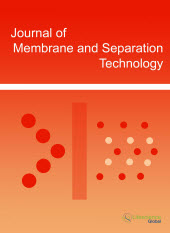jmst
Abstract : Heparin-Mimicking Polymer Modified Polyethersulfone Membranes - A Mini Review
|
|
Abstract: Recent studies on the modification of polyethersulfone (PES) membranes using heparin-mimicking polymers are reviewed. The general conception of heparin-mimicking polymersis defined as the syntheticpolymers (including the biopolymer derivates and synthetic sulfated artificial polymers) with similar biologically functionalities as heparin, such as the anticoagulant, growth factor binding, and also disease mediation. In the review, heparin-mimicking polymers is briefly reviewed; then heparin-mimicking polymer modified PES membranes, including blended, coated, and grafted membranes are discussed respectively. Keywords: Heparin-mimicking, polyethersulfone, blood compatibility, blending, coating.Download Full Article |
Abstract : Electrodialytic Removal of Cadmium from Brackish Water: Effects of Operating Parameters
|
|
Abstract: The continuous increase of environmental regulations make interesting to find effective and efficient methods for processing effluents containing metal ions. This research focuses on cadmium removal from brackish water by an electro-membrane process: The electrodialysis. Experiments were carried out on synthetic brackish water solutions and using a laboratory scale electrodialysis system. The influence of several parameters on process efficiency was investigated. The efficiency of this process was assessed by the determination of five parameters: The demineralization rate, the removal rate and the transport flux of cadmium, the current efficiency and the specific power consumption. The applied voltage, the feed flow rate, the pH and cadmium initial concentration of the feed solution have a significant effect on the process efficiency and mainly on the cadmium transfer from dilute to concentrate compartment. In contrast, feed ionic strength seems to affect only the SPC and not the R(Cd). Keywords: Electrodialysis, Synthetic brackish water, Demineralization rate, Cadmium removal, Process efficiency.Download Full Article |
Abstract : Preparation of PVDF UF Membranes under an External Electric Field with PVP as Additive
|
|
Abstract: In this study, PVDF UF membraneswere prepared with PVP as additive via a favorable method of applying high voltage external electric field (2kV) through the immersion precipitation phase inversion process. The influence of external electric field on the structure, surface functional groups, membrane potential, and surface hydrophilicity of the membranes were researched. In addition, anti-fouling property and separation performance of the membranes were also investigated. The results indicated that the protein adsorption amount on the electric treated membranes was distinctly reduced. Especially for the electric treated PVDF membrane with PVP K70 as additive, the value of water contact angle reached 75.4° and the protein adsorption amount decreased 76 %, reaching 20.39 µg·cm-2. The separation performance of the electric treated membrane was also superior to that of the un-treated membrane. All the experimental results indicatedthat this electric treated approach open a promising way for the modification of PVDF membrane because it combined membrane preparation and modification in only one physical step without additional chemical reagents. Keywords: Electric field, membrane potential, PVDF membrane, ultrafiltration, adsorption.Download Full Article |
Abstract : Maltodextrins Based Solid Membranes for the Enantioanalysis of L-Cysteine
|
|
Abstract: Three enantioselective membranes based on maltodextrins with different values of dextrose equivalent (DE) were proposed for the enantioanalysis of L-cysteine. The membranes were used for the design of potentiometric sensors. The slopes of the sensors were near-Nernstian (higher than 58.00mV/decade of concentration) with limits of detection of magnitude order of 10-11 and 10-12 mol/L. The surfaces of the membranes were stable for more than 6 months of continuous use. They can be renewed by polishing on alumina paper. Keywords: L-cysteine, solid enantioselective membrane, maltodextrin, enantioselective, potentiometric membrane electrode. |






















